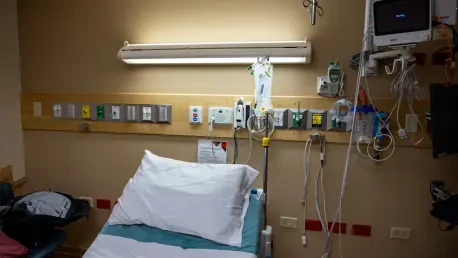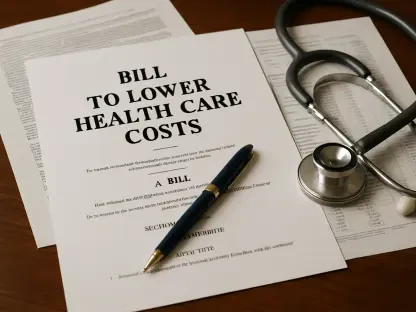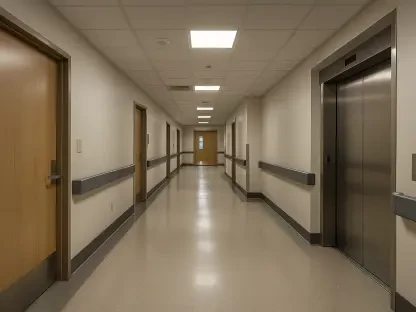In recent years, the outpatient healthcare sector has experienced financial success driven primarily by strategic mergers and acquisitions. This evolution has been supported by mounting healthcare spending, which increased by 7.5% in 2023, reaching a staggering $4.9 trillion, a figure that has consistently exceeded GDP growth rates. The dynamics shaping this trend also include a notable demographic shift, specifically an aging Baby Boomer population that increasingly demands diverse healthcare services. By 2033, projections indicate that individuals aged 65 and older will constitute 21% of the population, compelling health systems to adopt mergers and acquisitions as a fundamental tactic to keep pace with the growing need for outpatient facilities.
Economic Forces Shaping Healthcare’s Future
Growth in Healthcare Spending
The financial landscape of healthcare reveals a compelling pattern where annual growth rates for hospital and physician services—averaging 5.3%—have consistently surpassed GDP expansion from 2014 to now. This discrepancy is largely propelled by unrelenting demand for healthcare services, particularly among the aging demographic. Comparable growth in these sectors signifies a strategic pivot towards outpatient settings, attracted by the potential for high-revenue procedures. With aging Baby Boomers more prone to chronic illnesses, health systems are increasingly focusing on outpatient care, aiming to mitigate the mounting demands for complex and costly inpatient care.
As mergers facilitate the establishment of outpatient facilities, healthcare entities unlock opportunities to tap into previously inaccessible geographic locations while simultaneously broadening service offerings. The appeal of outpatient procedures lies not only in their potential for generating revenue but also in their ability to deliver patient-centered care. Conveniently located and typically requiring shorter patient visits, these facilities address the preference for efficiency and accessibility in healthcare. Thus, mergers provide a dual advantage: enhancing competitiveness and optimizing resource allocation, ultimately bolstering the position of outpatient care within the broader healthcare strategy.
Managing Chronic Conditions and Expanding Services
To manage the influx of aging patients grappling with acute and chronic conditions, healthcare providers must adapt their models to offer the right blend of services. Mergers have supported this transformation by allowing health systems to pool resources, consolidate expertise, and deliver multifaceted care strategies. The focus on outpatient settings aligns with the dual objectives of controlling costs and ensuring high-quality patient outcomes. By concentrating on outpatient services, healthcare providers are better equipped to handle the anticipated surge in the need for complex care without overwhelming traditional inpatient facilities.
Furthermore, the strategic emphasis on building outpatient capacity is crucial to handling the predicted increment in demand for complex and costly inpatient care. This shift not only underscores the financial prudence of expanding outpatient services but also highlights the necessity of anticipating future healthcare trends. Through mergers, health systems have the agility to meet current challenges head-on while poised to innovate and expand. They harness collaborative capabilities to navigate staffing challenges and ensure flexible deployment across various locations, providing services that respond to both immediate and future demographic needs.
Challenges and Strategic Shifts in Outpatient Care
Navigating Workforce Challenges
Despite the promising growth trajectory within the outpatient sphere, significant challenges remain, notably the looming shortage of healthcare professionals. In a landscape where efficient staff deployment is crucial, mergers have enabled systems to implement flexible staffing models across facilities. This strategic approach not only addresses immediate workforce challenges but also prepares organizations to adapt to fluctuating demands over time. By optimizing human resources, mergers help balance the supply of capable healthcare workers, ensuring quality care remains uninterrupted even amid workforce constraints.
Furthermore, mergers have facilitated technological integrations in outpatient care, enhancing operational efficiency. By adopting shared technology platforms, merging entities can streamline administrative processes, improve coordination, and empower healthcare workers with tools that enhance productivity. The ability to effectively utilize technology in managing patient care and improving service delivery underscores the critical role of technological investments within the context of mergers. Consequently, these advancements help offset staffing shortages while reinforcing the patient-centric focus vital for outpatient success.
Enhancing Patient Convenience and Satisfaction
The emphasis on outpatient facilities is not just an economic necessity but a response to patient desires for convenience and satisfaction. The burgeoning landscape of outpatient care aligns with contemporary healthcare consumption patterns where accessibility and patient experience are paramount. Through mergers and acquisitions, healthcare organizations fortify their ability to provide timely and personalized services, tailoring healthcare journeys in line with patient expectations. As a result, outpatient facilities rapidly evolve into crucial components of holistic healthcare strategies, shaping the future of care delivery.
These facilities also maintain a competitive edge by increasing patient loyalty and retention. With rising expectations for streamlined healthcare experiences, outpatient centers are strategically positioned to deliver services that align with the modern consumer ethos. Furthermore, mergers equip healthcare providers with the infrastructural capacity to innovate, experiment with new care models, and continuously improve service offerings. Such adaptability is pivotal in catering to a population increasingly concerned with both the quality and accessibility of healthcare services, maintaining a patient-centered focus that enhances satisfaction across the board.
Anticipating Future Healthcare Developments
In recent years, the outpatient healthcare sector has experienced notable financial growth, mainly driven by strategic mergers and acquisitions. This trend has been bolstered by increasing healthcare spending, which rose by 7.5% in 2023, reaching an impressive $4.9 trillion—a number continually surpassing GDP growth rates. Several dynamics contribute to this trend, including a significant demographic shift. Specifically, the aging Baby Boomer population is progressively demanding a wider array of healthcare services. As projections suggest, by 2033, individuals aged 65 and older will make up 21% of the population. This shift in demographic composition is pushing health systems to adopt mergers and acquisitions as crucial strategies to meet the escalating demand for outpatient services. Health organizations are thus focusing on expanding their capabilities to better serve this aging demographic, ensuring they can offer comprehensive, diverse, and accessible outpatient care in response to evolving market needs.









